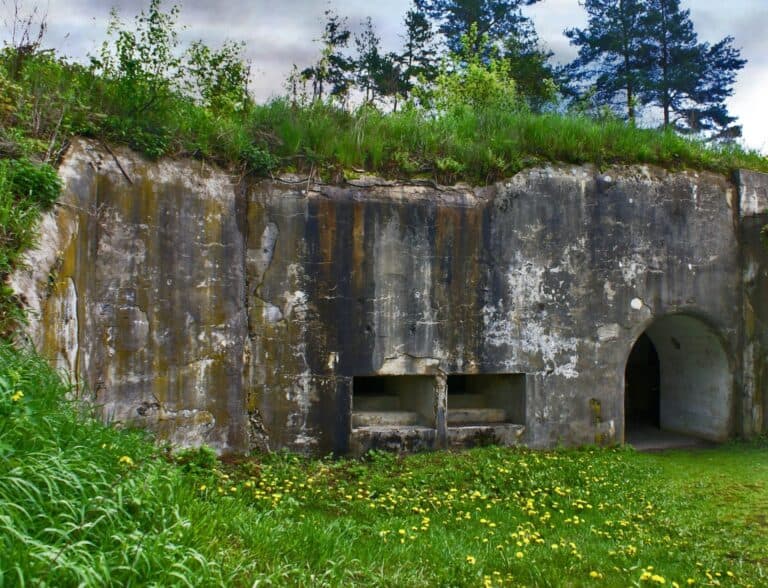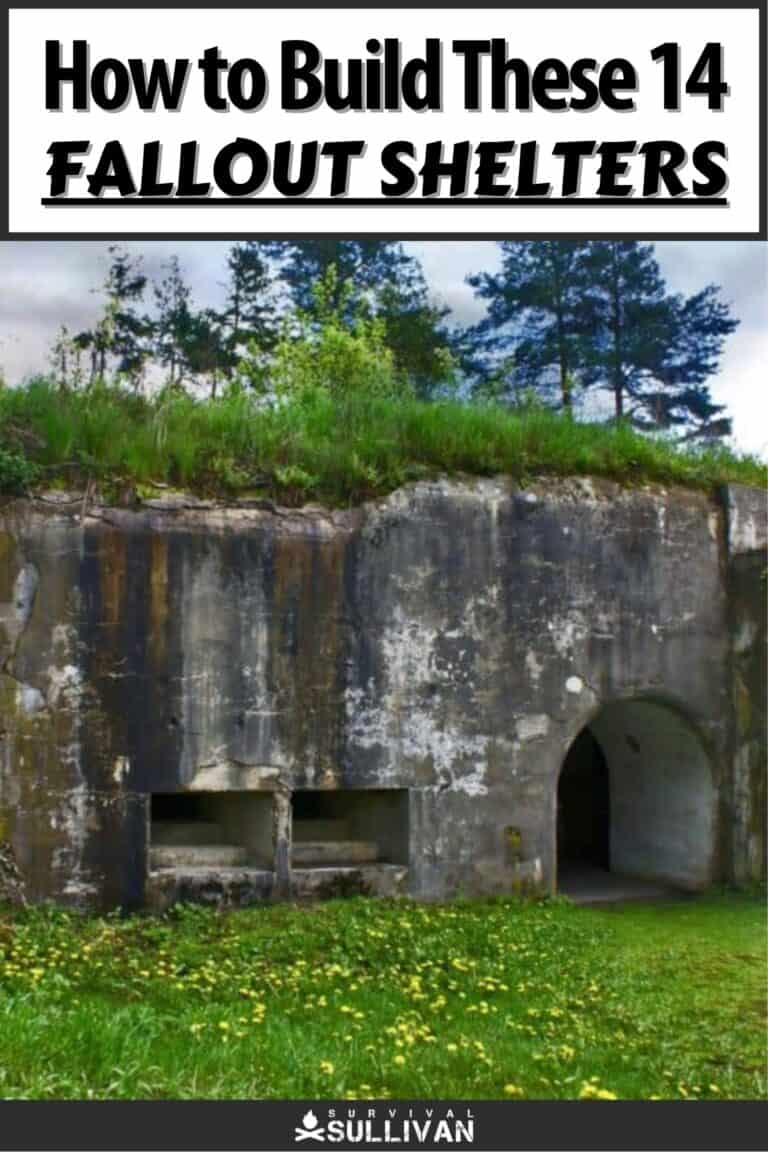With the way the world is going, there are many people in society who are feeling the chill brought on by the growing shadow of a nuclear war.

Although it is difficult, maybe even impossible to predict all ends, it is not difficult to imagine how one thing could lead to another concerning international conflict that would end with the exchange of tactical and then strategic nuclear weapons.
It makes total sense then that fallout shelters are once again a topic on the minds of everyone.
But you don’t need to be a mega-millionaire or a VIP to have access to a hardened underground bunker to keep yourself safe.
It is entirely possible, and perhaps cheaper than you think, to build a functional fallout shelter on your very own property, and maybe even in your home.
We have 14 such plans and designs for you below.
1. Traditional Fallout Shelter
Sometimes the most basic plans are the best for our purposes. The simple excavated earthen shelter is sufficient for providing protection from a nuclear blast and the resulting fallout that is sure to follow.
This plan relies on being underground and then covering the shelter with lots and lots of dirt to help attenuate radiation.
This plan, although comparatively simple, is fully featured in terms of protection, but it will take a heck of a lot of labor to install and finish if you don’t have access to heavy equipment.
If you have plenty of strong and able-bodied friends or family to help you, you might consider doing it manually, otherwise consider the rental of a backhoe to be necessary.
But other than that, this is a great plan, and simple to execute. Get the plans here.
2. Hasty, In-Room Fallout Shelter
When discussing fallout protection, many people immediately think of some sort of hardened underground room or other structure, one that is suitable for protecting against blast as well as the deadly fallout itself.
However, the fact of the matter is that you might not have any time or ability to access your shelter assuming you know where one is.
If you survive the blast you’ll still need to survive the fallout that is slowly making its way back to the ground.
This is where knowing how to quickly throw together a hasty fallout shelter might make the difference between life and death.
Using nothing more than common items you have in your home it is possible to increase your chances of surviving the arrival of fallout by improving your position inside a central room.
This is a principles-driven approach, one that is adaptable for anywhere you happen to be. Find out more at this link.
3. Tiny House Model Fallout Shelter
Tiny homes might be all the rage for people who want to live a minimalist lifestyle or just can’t afford larger and increasingly insane single-family housing prices.
You don’t have to live in a tiny house to make use of this shelter which relies on tiny house principles, though! In the end, you will have a fully featured, nicely outfitted, and livable if, uh, cozy fallout shelter.
It has a place to prepare food and dine, bunks for sleeping, multiple exits, ventilation, and more.
This will require more resources and more time to produce a finished shelter, but it makes a great standalone option or one that can be installed as part of an existing basement or other structure. Plans are here.
4. Dugout Earthen Fallout Shelter
In some places or with unlimited budgets, a fully subterranean shelter is just not achievable or practical.
In such a case, a partially underground shelter, or a dugout shelter, might provide all the protection you need for a lot less work, upkeep, and money.
This shelter functions by keeping most of the available space underground and supporting a taller roof with sturdy poles that will then be covered with sloped Earth for more protection against radiation and durability.
This shelter is an especially good idea if you’re forced to dig it out with manual labor or the soil on your property is very difficult to dig, period.
Aside from the initial dig, the rest of the construction is quite straightforward and well within reach of the average DIYer. Find out how right here.
5. Low-Cost Plywood Box Shelter
Everyone who has the money and access to resources would certainly prefer their shelter to be made out of lead, steel, or at least concrete.
The truth of the matter is that life gets in the way, and most of us are budgeting our resources for other things that we know we will need, not a shelter that we pray to God will never have to need.
But, this sentiment does not mean you cannot prepare against an unlikely, but still apocalyptic, disaster…
For decades, the government has been refining plans that will allow families to make entirely effective fallout protection using nothing more than plywood and other common, inexpensive building materials.
Even if you want a fallout shelter as a just-in-case option for relatively short-term scenarios, this is still a good one. Learn how to make it here.
6. Basement Concrete Block Shelter
For many preppers, the ideal shelter is one that is inside and accessible from your very own home.
There are practical and emotional reasons for doing so, but it is difficult to deny how attractive such an option is if it can be pulled off. Luckily, it can be, and perhaps cheaper than you think.
This plan is an improvement that can be installed in any finished or unfinished basement with a solid floor using nothing more than concrete blocks.
The good thing about this shelter is that it can do double duty as a tornado shelter and it will provide another measure of blast protection in the case of a near nuclear strike. Link.
7. Lean-To Fallout Shelter
If you want to ensure your family has protection from fallout but don’t want to spend big on shelter that may (or may not) save you from the devastating effects of a blast and you want to put the shelter together quickly over a weekend, this lean-to style fallout shelter might be the best fit for you.
Using simple materials and basic construction techniques, this is one shelter that can easily be constructed against a single wall in your basement, or even outside your home against an exterior wall.
It is definitely more cramped compared to some of the other larger shelters on this list that allow for more creature comfort and other equipment, but it will do the job of protecting your family for a short-term stay that will allow the worst of the radiation to subside in the immediate aftermath. Get the plans here.
8. Outside Concrete Shelter
Concrete is one of the very best materials for your fallout shelter if you can afford to implement it.
Although it is not quite as effective as steel, it does work well and is far more affordable and generally easier to work with.
If you want a larger outside fallout shelter for a sizable group or larger family, this is a great plan.
Once more, aside from the digging, this is work that a crafty person could do mostly by themselves if they have the prerequisite skills for setting and building with concrete.
I say this is probably the shelter design with the best overall protection factor at a modest cost. Get it here.
9. Brick Underground Shelter
Brick has much in common with concrete when it comes to radiation protection factors, but brick is still the material of choice for some people by default due to access, having a supply on hand, or any number of other reasons.
If you are one of these people, there’s no reason why you can’t make your fallout shelter from bricks instead of concrete.
You’ll probably recognize the design as similar to some of the other ones utilized in concrete blocks or poured concrete on this list, and that’s by design.
Bricks do have slightly different characteristics that you’ll have to account for when building with them but the resulting shelter will be strong just the same. Download here.
10. Underground Blast/Bomb-Resistant Fallout Shelter
One critical distinction that some preppers miss when assessing fallout shelters is assuming that any fallout shelter is also a bomb shelter. This is not always the case!
A fallout shelter, strictly defined, is only intended to protect the occupants from the radioactive danger of nuclear fallout, not the catastrophic effects of being inside the blast radius of a nuclear weapon.
It is possible to do both, to a degree and for a certain category of a nuclear weapon at a certain distance, but that shelter must be specially designed and reinforced to have any chance of protecting the people inside.
If you live near a likely nuclear target that a foreign enemy would send their missiles towards, you’ll need to build your shelter accordingly. Find out how with these plans.
11. Alternate Basement Shelter
As mentioned above, the basement fallout shelter is a popular concept, but not one that is one size fits all.
Depending on the size of your family and the size and layout of your basement you might need a different plan than the one listed above.
This is another good plan that is somewhat more adaptable to different spaces. Link.
12. Earthbag Root Cellar Shelter
Earthbags have been gaining a lot of popularity in recent years, or rather they have been rediscovered in recent years, as a low-cost, easy-to-work-with, and high-strength option for constructing all kinds of structures.
There is no reason you can’t put them to work building a fallout shelter, too.
The plan below is for a root cellar, nominally, but it has all the hallmarks of being a good fallout shelter with just a little bit of modification and some extra soil piled on top.
Check them out, look them over and see if they wouldn’t be the ideal solution for your own personal shelter, and you can always use it for storage in the meantime.
Just make sure you leave some room in case you have to clamber inside in a hurry! Plans are here.
13. Corrugated Steel Full/Half Shelter
Corrugated steel is a material that used to be a lot more popular for shelter construction back in the day, but it still has merits.
It offers an excellent strength-to-weight ratio, and when combined with piled Earth can work wonderfully for constructing compact but highly effective protective enclosures. It can also be utilized for the basement or other indoor shelters.
I wouldn’t rule out whatever sort of shelter you want, and the following plans will give you some ideas concerning what corrugated steel can do for you.
Whether you want a full-size and full-featured shelter, or a compact one suitable for short-term habitation, steel can make it possible. Get the plans right here.
14. Wooden Underground Shelter
If you are a skilled carpenter or just handy with wood, there’s no reason why you can’t use wood as the primary material for constructing your shelter.
Although it typically needs to be backed up by other, denser materials to provide considerable protection from penetrating radiation, using wood to make a larger or oversized shelter that can provide plenty of standoff to the occupants from the dangerous fallout outside is a viable strategy.
You can follow along on one man’s plan to do exactly that, and copy or modify his approach to suit your own purposes.


Tom Marlowe practically grew up with a gun in his hand, and has held all kinds of jobs in the gun industry: range safety, sales, instruction and consulting, Tom has the experience to help civilian shooters figure out what will work best for them.
